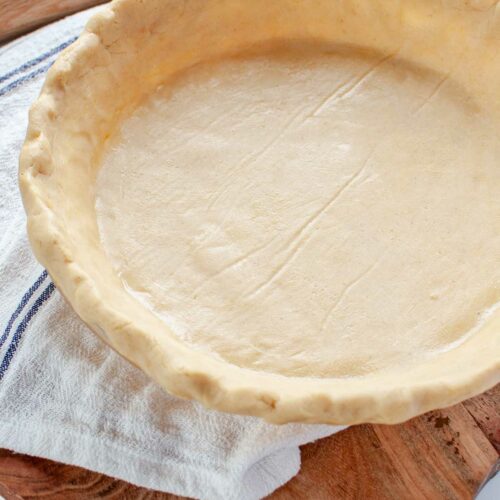
Paleo Pie Crust with Cassava Flour
Crisp and flaky crust made with cassava and tapioca flours! Perfect for a sweet or savory pie!
Equipment
- 1 8-9" pie pan
- 1 food processor optional
Ingredients
- 3/4 cups cassava flour
- 1/4 cup tapioca flour
- 1/2 tsp salt
- 1/4 tsp baking powder
- 1 tsp coconut sugar eliminate for a savory pie
- 1/2 cup sustainable palm shortening (or lard) this recipe was made with Spectrum
- 1 egg
- 1/2 tsp apple cider vinegar
- 2 tbsp water
Instructions
- If you need a top crust for your pie, simply double the recipe (hit the 2x button).
- Add cassava flour, tapioca flour, salt, baking powder, and coconut sugar to a food processor. (You can eliminate the coconut sugar if crust is for a savory pie.) Gently and quickly pulse a couple times to combine. You can also simply combine the ingredients in a bowl if you don't have a food processor.
- Add palm shortening and pulse several more times so that the flour and shortening combine. The shortening will be in small pea sized pieces and the dough will look crumbly at this stage. (Or if using a bowl, break up the shortening into the flour using your fingers, a pastry cutter, or a fork.)
- Add eggs and apple cider vinegar, then pulse a few more times until combined. Add water 1 tablespoon at a time until the dough just comes together and isn't crumbly. The dough will likely be more moist than a regular pie crust. (Simply stir with a spoon until combined if using a bowl.)
- Lay down a piece of parchment and sprinkle some cassava flour on the parchment. Remove the dough from the food processor or bowl and place on the floured parchment. Roll the dough around just so it comes together in a ball. *If you've doubled the recipe, divide the ball into two pieces, making the bottom crust dough ball slightly bigger than the other. Wrap the smaller ball in plastic wrap. If using right away, keep on the counter at room temperature. If using at a later time, place in the refrigerator, then remove and let sit on counter at room temperature so it becomes pliable again.
- Take the dough ball for the bottom crust and place it on the parchment (you may need to add more cassava flour if the parchment is sticky). Add another piece of parchment to the top and roll out the dough between the parchment sheets. Keep rolling into a circle until it is slightly larger than the pie pan. If the edges crack, mend them together using your hands.
- Remove the top piece of the parchment and gently flip over the dough onto the pie pan. Carefully peel back the parchment and push the dough down into the pie pan, lifting the edges of the dough as you push it down around the pan. The dough is delicate, so if it cracks and breaks, simply mend it back together using your fingers. Extra pieces of dough can be used to seal any cracks or holes.
- Roll up the crust that is hanging over the edge and pinch together to create a wavy pattern. If there are excess scraps that broke off the edge, roll these scraps into tube shapes and place the pieces around the rim of the pie pan, mending them together with the sides of the crust. Then pinch together the dough on the rim to continue the wavy pattern.
- Place pie pan with bottom crust in the refrigerator and refrigerate for 30 minutes (and up to 24 hours).
- Finish per your pie directions. If your pie requires a top crust, roll out the other half of the dough ball in the same way as the bottom crust. Carefully lay the crust over the filling and tuck in the edges.*Note that to ensure the bottom crust is not soggy, blind baking is recommended. Preheat the oven to 350°F degrees and partially bake the bottom crust for 15 minutes prior to adding filling and the top crust.To fully bake a bottom crust for a pie that does not require additional baking, bake for 30-35 minutes.
Notes
This recipe is for one crust. If your pie requires a top crust, simply click the 2x button on the recipe to double the amounts.
The nutrition values are based on 1/8 of one pie crust. If you double the dough for a top and bottom crust, double the nutritional values.
You can place pie weights or dried beans over parchment paper in the middle of the crust to keep it from puffing up during the blind bake (pre-bake), though typically the crust will settle back down into the pan on its own.
Nutrition
Calories: 183kcalCarbohydrates: 13gProtein: 2gFat: 14gSaturated Fat: 4gPolyunsaturated Fat: 4gMonounsaturated Fat: 6gTrans Fat: 2gCholesterol: 41mgSodium: 176mgPotassium: 18mgFiber: 0.2gSugar: 1gVitamin A: 59IUVitamin C: 1mgCalcium: 31mgIron: 1mg
Tried this recipe?Mention @slice.of.paleo or tag #slice.of.paleo so we can admire your work!